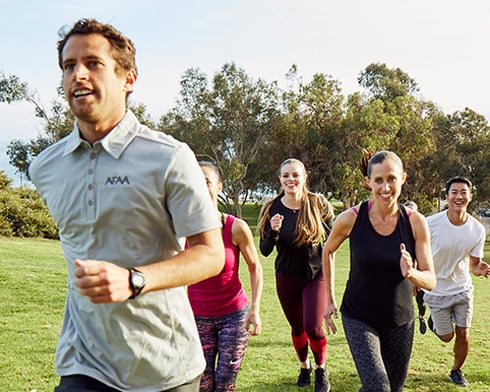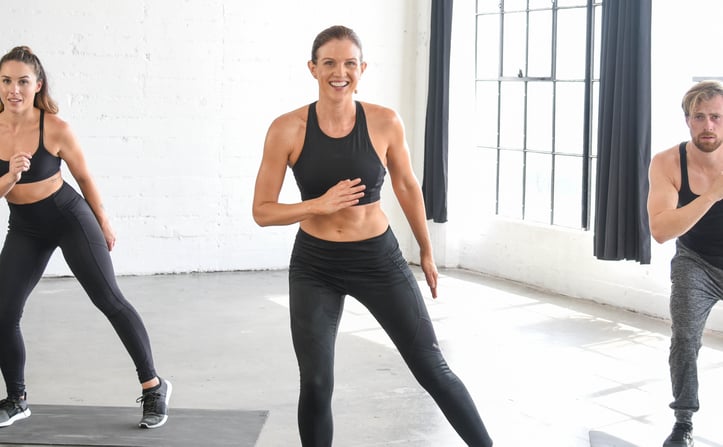Beyond the Basics: Fresh Programming Ideas for Your Traditional Cardio Workouts (Part 1)

Beyond the Basics: Fresh Programming Ideas for Your Traditional Cardio Workouts (Part 1)
Cardiovascular exercise, or "cardio" as most of us know it, is a cornerstone of a healthy, vibrant lifestyle. It’s not just about heart health (though that’s a huge plus!); consistent cardio helps with weight management, skyrockets your endurance, reduces stress, and leaves you feeling energized and capable.
But let's be honest, sometimes the same old cardio routine can start to feel a bit… stale. If you're ready to inject new life, effectiveness, and even a bit more fun into your runs, bike rides, or swims, you're in the right place! In this post (Part 1 of our series!), we'll explore some exciting programming ideas to elevate your traditional cardio exercises.
The "Why" Behind Cardio: A Quick Science Refresher
Before we jump into new strategies, let's quickly appreciate what's happening inside your amazing body during cardio. When you engage in activities like jogging, cycling, or dancing, your heart rate climbs, and you start to breathe a bit harder. This is your body calling for more oxygen to fuel your working muscles.
As you consistently challenge yourself with cardio, incredible adaptations occur:
- Your heart becomes a stronger, more efficient pump.
- Your lungs get better at taking in oxygen and expelling carbon dioxide.
- Your body becomes more adept at delivering that precious oxygen to your muscles. The result? Improved cardiovascular health, increased stamina for all of life's adventures, and a significantly reduced risk of chronic conditions like heart disease, type 2 diabetes, and obesity. Pretty amazing, right?
Your Cardio Toolkit: A Look at Traditional Favorites
There's a fantastic array of traditional cardio exercises to choose from, each offering unique benefits:
- Running/Jogging: A classic for a reason! Great for cardiovascular fitness, endurance, and can be done almost anywhere.
- Cycling (Indoor or Outdoor): A fantastic low-impact option that’s easier on the joints while still providing an excellent heart and leg workout.
- Swimming: A true full-body workout that’s incredibly joint-friendly, making it ideal for almost everyone, including those with injuries.
- Rowing: A powerhouse exercise that builds both upper and lower body strength and cardiovascular endurance.
- Jumping Rope: A surprisingly intense, portable, and fun way to get your heart rate up quickly and improve coordination.
The beauty is that each of these can be tailored to your current fitness level and specific goals.
Spice It Up! Fresh Programming Ideas for Your Cardio Routine
Ready to break out of your cardio rut? Let's explore some dynamic programming ideas to make your workouts more effective, engaging, and results-driven.
1. Interval Training: The Power of Peaks and Valleys
Interval training involves alternating between short, intense bursts of effort and periods of lower-intensity recovery. This "on-off" approach is incredibly effective for boosting cardiovascular fitness, torching calories, and improving endurance without the monotony of steady-state cardio.
- How to Try It:
- Running Example: Sprint for 30 seconds, then walk or jog slowly for 60-90 seconds to recover. Repeat this cycle for 20-30 minutes.
- Cycling Example: Pedal hard against higher resistance for 45 seconds, then spin easily with low resistance for 75 seconds.
- Why it Rocks: It challenges your body in new ways, can be less time-consuming, and often feels more engaging.
2. Circuit Training: Full-Body Cardio and Strength Fusion
Circuit training keeps things moving! You'll perform a series of different exercises (often a mix of cardio and bodyweight strength moves) back-to-back with minimal rest in between. It’s a fantastic way to improve cardiovascular health, build functional strength and endurance, and keep your metabolism humming.
- How to Try It: Create a circuit of 5-8 exercises. Perform each exercise for a set time (e.g., 45 seconds) or a set number of reps, then move immediately to the next. After completing all exercises in the circuit, take a short rest (e.g., 60-90 seconds) and repeat the entire circuit 2-4 times.
- Sample Circuit: Jumping Jacks, Bodyweight Squats, Push-ups (on knees is great!), Lunges (alternating legs), Plank, High Knees.
- Why it Rocks: It’s versatile, keeps boredom at bay, and efficiently works multiple fitness components at once.
3. High-Intensity Interval Training (HIIT): Short Bursts, Big Results
HIIT takes interval training up a notch. It involves very short, all-out bursts of exercise followed by brief recovery periods. HIIT is renowned for its efficiency in improving cardiovascular fitness, boosting metabolism (even after your workout is done – the "afterburn" effect!), and improving insulin sensitivity.
- How to Try It: The key is maximum effort during the work intervals.
- Sprint Example: Sprint as fast as you can for 20 seconds, then rest completely or walk very slowly for 10-40 seconds (the rest period can vary). Repeat for 10-20 minutes.
- Bodyweight HIIT: Explosive jump squats for 30 seconds, rest 15 seconds. Burpees for 30 seconds, rest 15 seconds.
- Why it Rocks: HIIT workouts are typically shorter, making them perfect for busy schedules, and they deliver impressive fitness gains. Important Note: Due to its intensity, HIIT is best incorporated 1-3 times per week, with adequate recovery.
4. Tabata Training: The 4-Minute Powerhouse
Tabata is a specific, super-charged form of HIIT. The protocol is precise: 20 seconds of ultra-high-intensity exercise followed by 10 seconds of complete rest, repeated for 8 rounds, totaling just 4 minutes per Tabata set. It’s incredibly challenging but highly effective.
- How to Try It: Choose one exercise (like squats, push-ups, burpees, or mountain climbers). Perform it with maximal effort for 20 seconds, rest for 10 seconds. Repeat this 8 times. You can do several Tabata sets with different exercises in one workout.
- Why it Rocks: It’s incredibly time-efficient and can significantly boost both aerobic and anaerobic fitness. Be warned: it's tough!
5. Cross-Training: Keeping Your Body Guessing (and Happy!)
Cross-training is all about variety. It involves incorporating different types of exercises and activities into your routine. This is fantastic for preventing boredom, reducing the risk of overuse injuries (by not stressing the same joints and muscles in the exact same way all the time), and developing well-rounded fitness.
- How to Try It: If you usually run, try adding a day of swimming or cycling. If you’re a cyclist, incorporate some rowing or trail running. Mix in strength training, yoga, or even a dance class.
- Why it Rocks: It keeps your workouts fresh and exciting, challenges your body in diverse ways, and can help you break through plateaus.
Pro Tips for Making Your Cardio Workouts Even More Effective (and Enjoyable!)
Beyond these programming ideas, a few key habits can elevate your cardio game:
-
Set Clear, Realistic Goals (Your Roadmap to Success): Vague goals lead to vague results. Use the SMART framework: make your goals Specific, Measurable, Achievable, Relevant, and Time-bound.
- Example: Instead of "I want to get better at cardio," try "I will complete a 25-minute interval run twice a week for the next 4 weeks." This clarity keeps you motivated and focused.
-
Embrace Variety in Your Routine (The Spice of Fitness Life!): Your body is smart and adapts quickly. Regularly changing things up – the type of cardio, the intensity, the duration, or the programming style – keeps your body challenged and your mind engaged.
-
Listen Intently to Your Body (It’s Your Best Coach): This is crucial. If you feel sharp pain or significant discomfort during your workouts, stop and assess. Don't push through true pain. Pay attention to your body's signals of fatigue and adjust your workouts accordingly. Some days you'll feel energetic; other days, you might need to scale back. That’s okay!
-
Stay Hydrated (Fuel Your Performance): Proper hydration is non-negotiable for effective workouts. When you exercise, you lose fluids through sweat, which can lead to dehydration if not replenished. Dehydration can zap your energy, cause dizziness, and lead to muscle cramps.
- Action Plan: Drink plenty of water throughout the day, and make sure to hydrate before, during (sips for longer sessions), and after your workouts.
-
Prioritize Rest & Recovery (Where the Magic Happens): Your body needs time to recover and adapt after exercise. If you don't allow for adequate rest, you risk injury, fatigue, and burnout.
- Action Plan: Aim for 7-9 hours of quality sleep per night. Incorporate active recovery days (like light walking or stretching) and complete rest days into your weekly schedule as needed.
Your Cardio Adventure Awaits!
Cardiovascular exercise is a powerful tool for enhancing your health and well-being. By trying out these fresh programming ideas and embracing these smart training tips, you can make your cardio workouts more effective, far more enjoyable, and incredibly rewarding.
Remember to set those inspiring goals, mix things up, listen to your body's wisdom, stay well-hydrated, and honor your need for rest. With a little effort and dedication, you'll not only achieve your fitness aspirations but also cultivate a deeper appreciation for what your amazing body can do.
So, what are you waiting for? Pick one new idea to try this week and see the results for yourself! We'd love to hear about your experiences and any other cardio tips you swear by – share them in the comments below!
Disclaimer: The information provided in this blog post is for general informational and educational purposes only, and does not constitute medical advice. It is essential to consult with your doctor or a qualified fitness professional before starting any new exercise program to ensure it is safe and appropriate for your individual health status and fitness level.

Fit vs Fat: Decoding Health's True Ruler

Pump Up Your Heart: Science-Driven Weight Loss

Wellness Technology: Your Path to Sustainable Weight Loss

A Sensible Guide to Dietary New Year's Resolutions

Prevent Shoulder and Rotator Cuff Injuries with Corrective Exercises

Overcome Fitness Plateaus: 4 Tips for Success

10 x 10 Thanksgiving Day Circuit: A Fitness Guide

Unleash Your Fitness Potential with Kit Rich's Training Secrets

The Future of Fitness: A Guide for Beginners to Intermediates

